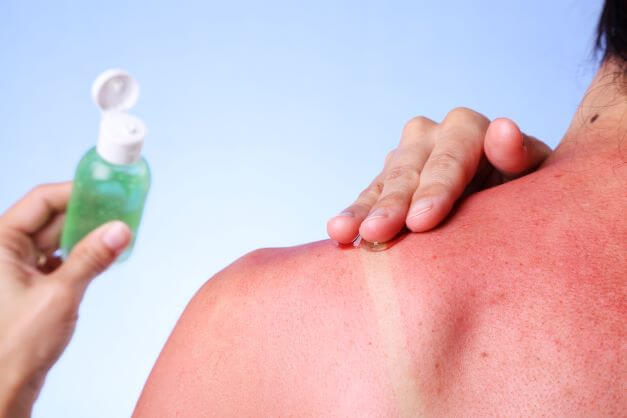Summertime means fun in the sun. Barbeques. Swimming. Hiking. Camping. Unfortunately, for many people, these summer activities have one thing in common – sunburns. According to Dr. Adam Luber of U.S. Dermatology Partners in Phoenix and Scottsdale, Arizona, “If you’re a light-skinned person or someone who has skin that is extra sensitive to sunlight, summertime means you’re probably being extra vigilant with your sunscreen and wearing sun-protective clothing. But, you may also still be dealing with the occasional sunburn. There’s no magic overnight remedy for getting rid of sunburns, but your dermatologist can definitely help you create a plan to manage the symptoms and heal more quickly with less discomfort.” In this blog, Dr. Luber will discuss the best sunburn relief treatment options for at home and help you determine when it’s time to schedule a visit to see your dermatologist.
What Are Sunburns & Why Do They Happen?
Sunburns occur when the skin receives too much exposure to ultraviolet (UV) rays. These rays typically come from the sun, but they can also come from tanning beds and other sources of UV light. People who have pale skin are much more likely than those with darker skin to experience sunburns even with less sun exposure. This is because darker skin has a greater amount of melanin, the pigment-producing part of the skin. Melanin helps to protect the body from damaging UV rays. If you burn easily or spend a lot of time outdoors, you are at increased risk for a sunburn, and you need to take steps to protect your skin every day. However, even if you do have a darker skin tone or don’t burn as easily, the sun can still damage your skin. Daily sunscreen application can reduce your risk for other forms of sun damage like skin cancer and accelerated signs of aging like fine lines and wrinkles.
How Can I Get Instant Sunburn Relief?
According to Dr. Luber, “Unfortunately, there really isn’t an instant sunburn cure. You are going to have to muddle through some uncomfortable days, especially if you have a severe sunburn. However, there are some tricks you can use to relieve the symptoms and promote faster skin cell turnover and healing after a sunburn.”
Some of the simple steps you can take for fast relief from sunburn symptoms include:
- Take a cool bath or shower – Hot water on sunburned skin is painful, and it can take even more moisture out of your already dry and damaged skin. Instead, take a cool bath or shower as soon as you feel your skin start to heat up. It soothes the burn, and won’t strip moisture from your skin. For an added boost, include baking soda in your bath (about two cups). This helps to reduce skin redness and irritation caused by sunburn.
- Skip the soap – All types of soap, even those that are very gentle, are drying. They strip away all the oils and residues from the skin. In most cases, this is a positive thing, but sunburned skin needs all the moisture it can get. Skip using soap for a few days after a sunburn. Instead, rinse the affected area with cool water and apply a deep moisturizer several times a day.
- Use cold compresses and ice packs – If there are areas where your burn is most concentrated, apply cold compresses or ice packs to those areas for a few minutes at a time. Not only does this help to relieve the heat of sunburn, but cold also constricts blood flow and reduces inflammation and pain.
- Take a pain reliever – Over-the-counter pain killers can significantly help to relieve pain. If you know you’re developing a sunburn, go ahead and take your preferred pain relief product to minimize your discomfort.
- Take special care of facial sunburns – If you have sunburns on your face, especially around your eyes or mouth, you may want to consider using tea to relieve your discomfort. Unflavored green or chamomile tea usually work best, and they have antioxidants that can promote healing. If you have burning around the eyes, soak the tea bags in cold water for a few minutes. Then, place them directly onto your closed eyelids. To treat a larger area, allow the tea bags to soak in cool water for several minutes. Then, place a washcloth in the water for a few seconds before placing it over your face.
- Take care of yourself – When you’re healthy, your skin will have all the nutrients it needs to heal itself, so drink plenty of water, eat a nutritious diet, and get a lot of sleep.
- Don’t pick at your skin – Whether you have blisters from the burn or peeling skin, fight the urge to peel, poke, or scratch. This can lead to infections and may increase your risk for long-term skin damage like scarring and changes in skin tone or texture. Never pop blisters. This is your body’s natural form of protection as the skin heals.
- Stay out of the sun – This may seem like a no-brainer, but many people with sunburns end up making things worse by spending more time in the sun. Sometimes, this can’t be avoided, but you should definitely limit your sun exposure significantly. Make sure you apply sunscreen, and whenever possible, wear clothing that covers the affected area.
What Other Sunburn Treatments Are Available?
Dr. Luber says, “If you use the symptom-relief steps from the previous section, you should start to see improvement pretty quickly. If you have a more severe burn, or these treatments aren’t helping, you can also try some additional products that are used to address specific symptoms of sunburn.” Some great, dermatologist-approved sunburn relief products include:
- Moisturizers – A good moisturizer for the face and body should already be part of your morning and evening skincare routine. If you have a sunburn, you may want to invest in a heavier moisturizing cream. Sunburns strip moisture, and healing a sunburn means replacing that moisture. Find a deep moisturizing lotion and apply it to the affected areas several times a day.
- Colloidal oatmeal – You can find this ingredient in numerous lotions, bath soaks, and other products. It offers soothing, anti-inflammatory relief for sunburned skin, and it helps to create a barrier to trap in moisture and protect skin from further damage. Many products recommended for people with eczema include this ingredient, so look for eczema in the product name or a stamp from the National Eczema Association.
- Aloe vera – Whether you take this product directly from the plant or buy a gel or lotion in the store, aloe vera helps to soothe and cool burned skin, increases moisture, and promotes faster healing for all kinds of burns.
- Hydrocortisone – If your sunburn is itching as it heals, applying hydrocortisone cream can help to soothe the itch, diminish pain, and reduce swelling.
- Take a bleach bath – This one can sound a little scary, but it’s actually safe and effective. Mixing a small amount of bleach (about ¼ cup in a standard-sized bathtub) into your bath water will create hypochlorous acid, a natural element that the body uses to fight infections. A low concentration of bleach in your bath water can help with inflammation, promote healing, and prevent infection.
- Use a Petrolatum product – Petroleum jelly or petrolatum creates a protective barrier over burns, allowing them to heal and trapping in moisture while also cooling the sunburned area. Unfortunately, applying an adequate amount of petrolatum to extensive sunburned areas of skin may end up being messy and uncomfortable rather than helpful. If you have a smaller burn area or specific areas that are burned more severely, this may be a good option.
- Wear the right clothes – Choose soft fabrics and loose-fitting clothing to cover and protect your sunburned skin without adding more pain and irritation. If you’re going to be back out in the sun, wear a brimmed hat to protect your face, neck, and shoulders. You may also want to invest in UV protective clothing to prevent further sun damage.
- Hacks for sleeping with sunburns – You need sleep for your body to heal, but sleeping with a sunburn can be a struggle. The key is to find ways to keep your body cool and reduce friction that can irritate the skin. If you have access to sheets made of silk or other materials that are slick and cool to the touch, this can help you feel more comfortable. You can also find cooling mats that draw heat away from the body as you sleep. These are usually available in camping and sporting goods stores.
Can I Prevent Sunburns?
According to Dr. Luber, “The best way to treat a sunburn is to never get one in the first place. I know it’s easier said than done, especially during the summer months, but protecting your skin from the sun’s UV rays before damage occurs is important.” Some effective sunburn prevention techniques include:
- Wear sunscreen – Everyone should apply sunscreen daily to the parts of their body that will be exposed to the sun, but this is especially important if you’re going to be outdoors for an extended time. You should apply an adequate amount of sunscreen (about an ounce) at least every two hours. Choose a product with a sun protection factor (SPF) of 30 or higher, and look for broad-spectrum products. That means they protect your skin from UVA and B rays.
- Minimize sun exposure – Take breaks in the shade when you’re outdoors, especially between 10 am and 4 pm when the sun’s rays are strongest.
- Cover up – Wear lightweight clothing that covers up your arms and legs, put on a hat, and consider wearing UV protective clothing. You can also sit under an umbrella or awning if you’re going to be outdoors.
- Don’t skip the sunglasses – Your eyes may not get sunburned, but they can be damaged by excessive sun exposure. So, wear sunglasses to help prevent eye strain, ocular melanoma, and other eye issues.
When Should I Call U.S. Dermatology Partners for Sunburn Treatment?
In some cases, you really need to work with a dermatologist to heal sunburns. Specifically, you should contact U.S. Dermatology Partners for an appointment in any of the following situations:
- When a baby or toddler is sunburned
- You feel tired, dizzy, feverish, nauseous, or develop muscle cramps
- You have an unexplained headache
- Skin discoloration (usually purplish)
- Pain or itching that is severe or keeping you from sleep
- You have blisters or excessive swelling
- You take medications that can lead to complications (antibiotics, antifungals, tranquilizers, blood thinners, oral contraceptives, diabetes medications, or diuretics)
Find a location near me
or


